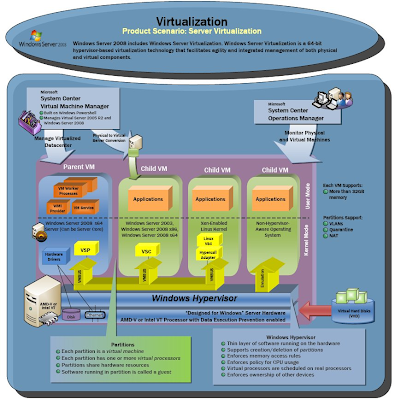Bare Metal Hypervisors
August 24, 2009 (Network World eEdition) - The phrase “bare-metal client hypervisor” is a mouthful, but one IT execs ought to get used to saying in the coming years. As the name suggests, this type of hypervisor sits directly on top of hardware--desktop computers, laptops, perhaps even smartphones one day--running independently from the operating system.

Download a copy of Microsoft Hyper-V Server 2008.
“This is exciting technology,” says Chris Wolf, a senior analyst with Burton Group. “It provides enterprises with a tremendous amount of flexibility.” One desktop, multiple VMs One reason for his enthusiasm, Wolf says, is the ability to run multiple virtual machines (VM) on top of a bare-metal client hypervisor. A user machine takes on a whole new personality under this type of architecture. On a desktop computer outfitted with a client hypervisor, for example, you might find corporate-sanctioned and supported operating system and applications running on a locked-down VM. Personal applications, like iTunes and digital picture portfolios, as well as an individual’s preferred operating system, would sit atop another VM. What goes on in one VM has nothing to do with and is never impacted by any other VM on the same client and, perhaps best yet, IT doesn’t have to support the personal VMs or anything running on them, Wolf says.
Likewise, you might find software developers running Linux and Windows VMs side by side on their desktops. The former would host their core development tools while the latter business applications like e-mail and calendaring, says Doug Lane, senior director of product management and marketing at Virtual Computer, a startup with a bare-metal client hypervisor called NxTop.
Enterprises might one day even offer “build your own PC” programs, much as many do today with cell phones. Employees can use a company-provided voucher to buy the omputer model they like best from a predetermined list. They can run their personal and work environments on the same system, but all support comes from the PC maker, not internal IT.
Bare-metal client hypervisors also will play a big role in virtual desktop infrastructures in which virtual desktops are hosted at central sites and downloaded on user request. Because bare-metal hypervisors don’t rely on the client operating system, IT can create or update one image--say by applying a Windows patch--and publish that out across the virtual desktop infrastructure.
By Beth Schultz

Download a copy of Microsoft Hyper-V Server 2008.
“This is exciting technology,” says Chris Wolf, a senior analyst with Burton Group. “It provides enterprises with a tremendous amount of flexibility.” One desktop, multiple VMs One reason for his enthusiasm, Wolf says, is the ability to run multiple virtual machines (VM) on top of a bare-metal client hypervisor. A user machine takes on a whole new personality under this type of architecture. On a desktop computer outfitted with a client hypervisor, for example, you might find corporate-sanctioned and supported operating system and applications running on a locked-down VM. Personal applications, like iTunes and digital picture portfolios, as well as an individual’s preferred operating system, would sit atop another VM. What goes on in one VM has nothing to do with and is never impacted by any other VM on the same client and, perhaps best yet, IT doesn’t have to support the personal VMs or anything running on them, Wolf says.
Likewise, you might find software developers running Linux and Windows VMs side by side on their desktops. The former would host their core development tools while the latter business applications like e-mail and calendaring, says Doug Lane, senior director of product management and marketing at Virtual Computer, a startup with a bare-metal client hypervisor called NxTop.
Enterprises might one day even offer “build your own PC” programs, much as many do today with cell phones. Employees can use a company-provided voucher to buy the omputer model they like best from a predetermined list. They can run their personal and work environments on the same system, but all support comes from the PC maker, not internal IT.
Bare-metal client hypervisors also will play a big role in virtual desktop infrastructures in which virtual desktops are hosted at central sites and downloaded on user request. Because bare-metal hypervisors don’t rely on the client operating system, IT can create or update one image--say by applying a Windows patch--and publish that out across the virtual desktop infrastructure.
By Beth Schultz


Comments